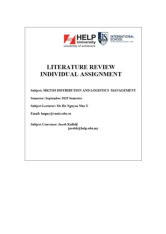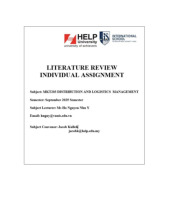









Preview text:
lOMoAR cPSD| 59981978 ̃
Vietnam National University –
International School (VNU-IS)
September 2023 Semester ASSIGNMENT 1 Subject: MKT 203
Distribution and Logistics Management Semester: September 2023 Student Name: Nguyen Duc Manh Student Code: 22070705
RISE OF THE IMPORTANCE OF LOGISTICS
The importance of logistics has expanded dramatically over the past two decades as
they contribute a significant component of a country’s GDP. In 2022, Vietnam's
transportation and storage sector accounted for 4.65 percent of the country's total GDP,
equivalent to over 442.3 trillion Vietnamese dong. In that year, Vietnam's total GDP
amounted to 9.5 thousand trillion Vietnamese dong. [1] This development has been
fueled by a convergence of tremendous forces that have reshaped how goods are moved,
stored, distributed domestically and abroad. The following content presents the five
forces and how they gave rise to the importance of logistics in a country’s GDP.
Five forces that gave rise to the importance of logistics:
1. Competition between rivals withtin the industry:
In the past, logistics was often seen as a necessary evil, a cost that had to be
borne in order to get goods from one place to another. However, as the logistics
industry has become more competitive, companies have begun to realize that
logistics can be a source of competitive advantage. There are a number of ways in
which competition in the logistics industry has led to an increased focus on logistics.
First, companies are constantly looking for ways to reduce their costs. Logistics
is a significant cost for many companies, so even small improvements in efficiency
can have a big impact on the bottom line. Second, companies are looking for ways
to improve their customer service. This includes getting products to customers faster
and more reliably. Logistics plays a crucial role in customer service, so companies
are investing in new technologies and processes to improve their logistics
operations. Finally, companies are looking for ways to differentiate themselves from
their competitors. Logistics can be a way to do this by offering unique services or
by excelling in areas such as speed, reliability, or flexibility. [2]
Here are some specific examples of how competition in the logistics industry
has led to an increased focus on logistics:
• The rise of e-commerce has led to a demand for faster and more reliable
delivery. This has forced logistics companies to invest in new technologies
and processes to meet the needs of e-commerce customers. [3]
• The growth of global supply chains has made logistics more complex and
challenging. This has led to a demand for logistics companies that can 1
provide end-to-end solutions that can handle all aspects of the supply chain,
from transportation to warehousing to customs clearance. [4]
• The increasing competition among logistics companies has led to lower
prices and higher quality services for customers. This has made logistics
more affordable and accessible for businesses of all sizes. [5]
2. Threat of new entrants – defense against threats of new rivals entering the industry
2.1. Threat of new entrants
The threat of new entrants is one of the five competitive forces identified
by Michael Porter in his Five Forces of Competition framework. It refers to
the potential for new companies to enter an industry and compete for market
share. The threat of new entrants is high when there are low barriers to entry,
such as low startup costs, easy access to resources, and few regulations. [6]
2.2. Defense against threats of new rivals entering the industry
Companies can defend themselves against the threat of new entrants by
developing and maintaining competitive advantages. One way to do this is
to invest in logistics. Logistics includes all the activities involved in moving
goods from suppliers to customers, including transportation, warehousing,
and inventory management. An efficient and effective logistics system can
give a company a significant advantage over its competitors. [7]
2.3. How the threat of new entrants gave rise to the importance of logistics in a country's GDP
The threat of new entrants has given rise to the importance of logistics in
a country's GDP in a few ways.
First, as companies have invested in logistics to improve their efficiency
and competitiveness, this has led to the growth of the logistics industry as a
whole. Second, the growth of the logistics industry has created jobs and
generated tax revenue. Third, the logistics industry supports other industries,
such as manufacturing, retail, and e-commerce. By making it easier and more
efficient to move goods, logistics helps these industries to operate more
effectively and efficiently. This leads to lower costs for businesses, which
can then be passed on to consumers in the form of lower prices. [8]
3. Threat of substitute – defense against the threat of potential customers using
substitute products
The threat of substitute is one of the five forces that Porter's Five Forces
Analysis identifies as the main competitive forces that shape the profitability of an
industry. The threat of substitute is the degree to which buyers can switch to using
alternative products or services that are not offered by the company. This can reduce
the company's pricing power and profitability. 2
The threat of substitute can give rise to the importance of logistics in a country's
GDP in a number of ways. For example:
• If a country's businesses are facing strong competition from foreign
businesses, they may be forced to lower their prices or to improve their
quality or delivery times in order to remain competitive. This can put pressure
on businesses to reduce their costs, which can lead to them investing in more
efficient logistics solutions. [6]
• If a country's businesses are producing goods or services that are easily
substitutable, they may be more vulnerable to competition from foreign
businesses. In this case, logistics can play a vital role in helping businesses
to differentiate their products or services from the competition. For example,
a business that produces clothing may be able to compete more effectively if
it is able to offer faster delivery times or a wider range of customization options. [7]
• Logistics can also help businesses to reduce their environmental impact,
which can become increasingly important as consumers become more
concerned about the environment. By reducing the amount of transportation
required to move goods from one place to another, businesses can reduce
their carbon emissions and other environmental impacts. This can make
businesses more attractive to consumers and can help them to compete more
effectively in the global marketplace. [8]
4. Supplier power – the power of suppliers in negotiating and maintaining raw
material supply parameters
Supplier power is the ability of suppliers to influence the prices, terms, and
conditions of supply. It is a powerful force that can have a significant impact on
businesses and the economy. It is able to enhance the significance of logistics in the economy in a number of ways:
• Increased demand for logistics services: When suppliers have more power,
they are more likely to demand specific logistics services from their buyers.
This could include things like faster delivery times, smaller order quantities,
and more customized packaging. This increased demand for logistics
services can lead to growth in the logistics industry and create new jobs. [9]
• Improved efficiency and productivity: Supplier power can also motivate
businesses to improve their logistics operations. This is because businesses
need to be able to meet the demands of their suppliers in order to maintain a
good relationship and secure a reliable supply of raw materials. Improved
logistics operations can lead to lower costs, faster delivery times, and better customer service. [7] 3
• Innovation in logistics: Supplier power can also drive innovation in the
logistics industry. This is because businesses are constantly looking for ways
to improve their logistics operations in order to meet the demands of their
suppliers. This can lead to the development of new technologies and
processes that can make the logistics industry more efficient and effective. [8]
Here are some specific examples of how supplier power can enhance the
significace of logistics in the economy:
• A major automotive manufacturer may have a lot of supplier power over its
suppliers of key components, such as engines and transmissions. This
supplier power could be used to demand faster delivery times, lower prices,
and higher quality components. This could lead to the automotive
manufacturer improving its logistics operations in order to meet the demands of its suppliers. [9]
• A large retail chain may have a lot of supplier power over its suppliers of
consumer goods. This supplier power could be used to demand smaller order
quantities, more frequent deliveries, and customized packaging. This could
lead to the retailer improving its logistics operations in order to meet the
demands of its suppliers. [9]
• A technology company may have a lot of supplier power over its suppliers of
electronic components. This supplier power could be used to demand faster
delivery times, higher quality components, and greater flexibility in supply
arrangements. This could lead to the technology company improving its
logistics operations in order to meet the demands of its suppliers. [9]
5. Buyer power – the power of buyers in determining finished goods availability and
supply parameters
Buyer power can improve the importance of logistics in the financial system in many ways:
• Increased demand for faster and more efficient delivery: Buyers with strong
bargaining power can demand faster and more efficient delivery of goods and
services. This can lead to increased investment in logistics infrastructure and
technologies, which can benefit the financial system as a whole. [8]
• More sophisticated logistics requirements: Buyers with strong bargaining
power can also demand more sophisticated logistics services, such as
trackand-trace capabilities, real-time inventory updates, and customized
delivery options. This can create new opportunities for financial institutions
to provide innovative logistics solutions. [8] 4
• Greater use of financial products and services to manage logistics costs:
Buyers with strong bargaining power can use a variety of financial products
and services to manage their logistics costs, such as supply chain financing,
inventory financing, and transportation insurance. This can help to reduce the
overall cost of logistics and make it more accessible to businesses of all sizes. [8]
• Increased transparency in the logistics industry: Buyers with strong
bargaining power can also demand greater transparency in the logistics
industry. This can lead to more efficient pricing and service levels, which can
benefit both buyers and sellers. [8]
These following are the most representative examples of how buyer power is
already being used in this industry:
• Amazon: Amazon is known for its ability to negotiate lower prices with
logistics companies due to its large volume of shipments [10]. In addition,
Amazon has been using its bargaining power to push for more sustainable
transportation methods, such as electric vehicles [11].
• Walmart: Walmart has been using its buyer power to push for more
sustainable packaging and transportation methods. In addition, Walmart has
been working with logistics companies to develop new technologies that
improve supply chain efficiency. [11]
• Procter & Gamble: Procter & Gamble has been using its buyer power to push
for more sustainable transportation methods and packaging. In addition,
Procter & Gamble has been working with logistics companies to develop new
technologies that improve supply chain visibility and efficiency. [11]
• Unilever: Unilever has been using its buyer power to push for more
sustainable transportation methods and packaging. In addition, Unilever has
been working with logistics companies to develop new technologies that
improve supply chain visibility and efficiency. [11]
These are just a few examples of how buyer power is being used to improve the
importance of logistics in the financial system. As buyer power continues to grow,
it is likely that we will see even more innovation and investment in the logistics sector.
Force that continue to influence the growth of logistics and
distribution in the next 5 to 10 years in Vietnam
All five forces are likely to continue to influence the growth of logistics and
distribution in the next 5 to 10 years. However, In my opinion, the most influential
force that will continue to influence the growth of logistics and distribution in
Vietnam is the threat of new entrants. The entry barriers are low, giving new entrants 5
a wide berth to play in the field. Sharing business models have provided a platform
for new business models. These asset-light new start-ups are utilizing the latest
technology to offer interactive benchmarking of the rates of existing air and shipping
companies and match them in their available capacity with delivery needs [12]. This
will lead to increased competition among logistics companies, which will drive
innovation and improve service quality.
The next thing in the future that drives logistics
The logistics industry is expected to undergo significant changes in the future.
According to a report by Financial Times, the pandemic has transformed logistics
from an aspect of procurement into a competitive advantage driving success for
certain companies. [13]
Here are some of the trends that are expected to drive logistics in the future:
• Sustainability: Sustainability is becoming increasingly important in the
logistics industry. Logistics companies are under pressure to reduce their
carbon footprint and adopt more environmentally friendly practices. [14]
• Technology: Technology is transforming the logistics industry, with new
innovations such as autonomous vehicles, drones, and blockchain technology
being developed [15]. These technologies have the potential to improve efficiency and reduce costs.
• Multimodal shipping: Multimodal shipping uses multiple forms of transport
to deliver goods in a timely and cost-effective manner. It combines the best
of both worlds: the rapid shipping time of air and the cost savings of sea.[14]
• Supply chain resilience: The COVID-19 pandemic has highlighted the
importance of supply chain resilience. Companies are expected to focus on
improving supply chain resilience through better risk management,
diversification, and contingency planning. [13]
• E-commerce: The rise of e-commerce has led to an increase in demand for
logistics services, particularly last-mile deliver [16]. As more consumers
shop online, logistics companies will need to adapt to meet their needs.
These are some of the trends that are expected to drive logistics in the future.
How factors like globalization, technological advancement and
forth could influence the growth
Globalization and technological advancement are two of the most significant
factors that are expected to influence the growth of the logistics industry in the
future. According to a report by McKinsey & Company, globalization has led to an
increase in international trade, which has driven demand for logistics services[17]. 6
As more companies expand globally, logistics companies will need to adapt to meet their needs.
Technological advancements are transforming the logistics industry, with
new innovations such as autonomous vehicles, drones, and blockchain technology
being developed. These technologies have the potential to improve efficiency and
reduce costs. For example, autonomous vehicles can reduce delivery times and costs
by eliminating the need for human drivers. Drones can be used for last-mile delivery
in areas that are difficult to access by road. Blockchain technology can improve
supply chain transparency and security by providing a tamper-proof record of transactions. [18]
In addition to globalization and technological advancement, other factors that
could influence the growth of the logistics industry include sustainability,
multimodal shipping, and supply chain resilience. Sustainability is becoming
increasingly important in the logistics industry as companies are under pressure to
reduce their carbon footprint and adopt more environmentally friendly practices[19].
Multimodal shipping uses multiple forms of transport to deliver goods in a timely
and cost-effective manner [17]. Supply chain resilience has become more important
due to the COVID-19 pandemic, with companies focusing on improving risk
management, diversification, and contingency planning [19].
These factors are expected to drive growth in the logistics industry in the future. 7 REFERENCES:
[1] Nguyen Minh Ngoc, “GDP contribution of the transportation and storage sector
in Vietnam from 2015 to 2022”, 2023.
[2] Ronald H. Ballou, “Business logistics: Supply chain management: Planning,
organizing, and controlling the movement, storage, and warehousing of goods
and materials: A strategic approach to management”. Pearson Education, 2019.
[3] Deloitte, “E-Commerce Logistics Trends 2023”, March 2023.
[4] McKinsey & Company, “The Future of Global Supply Chains”, January 2023.
[5] “The Global Logistics Market 2023-2028”, Market Research Future, August 2023.
[6] Michael E. Porter, “How Competitive Forces Shape Strategy”, Harvard Business
Review, March-April 1979.
[7] Michael E. Porter, “Competitive Advantage: Creating and Sustaining Superior Performance”, 1985.
[8] “The Future of Logistics: A Perspective on the Next Decade”, World Economic Forum, 2019.
[9] Michael E. Porter, “The Five Forces of Competition”, Harvard Business Review, March-April 1979.
[10] Dan, “Supplier Power (one of Porter’s Five Forces)”, July 2013.
[11] Lars de Bruin, “Porter’s Five Forces, B2U”, August 2016.
[12] adamkasi, “Porter's Five Forces Model of Logistics Industry”, July 2017.
[13] Future of Logistics, Financial Times.
[14] “This is what the future of logistics looks like”, World Economic Forum, October 2022.
[15] Senerity Gibbons, “7 Trends That Could Change The Logistics Industry Forever”, May 2022.
[16] “FOREVER ALTERED: THE FUTURE OF LOGISTICS REAL ESTATE
DEMAND”, PROLOGIS, March 2021.
[17] Susan Lund, James Manyika, Jonathan Woetzel, Jacques Bughin, Mekala
Krishnan, Jeongmin Seong and Mac Muir, “Globalization in transition: The
future of trade and value chains”, January 2019. 8
[18] “How is technology transforming logistics?”, World Economic Forum, April 2015.
[19] Kashyap Deorah, “Why Logistics Technology Matters”, December 2021. 9



